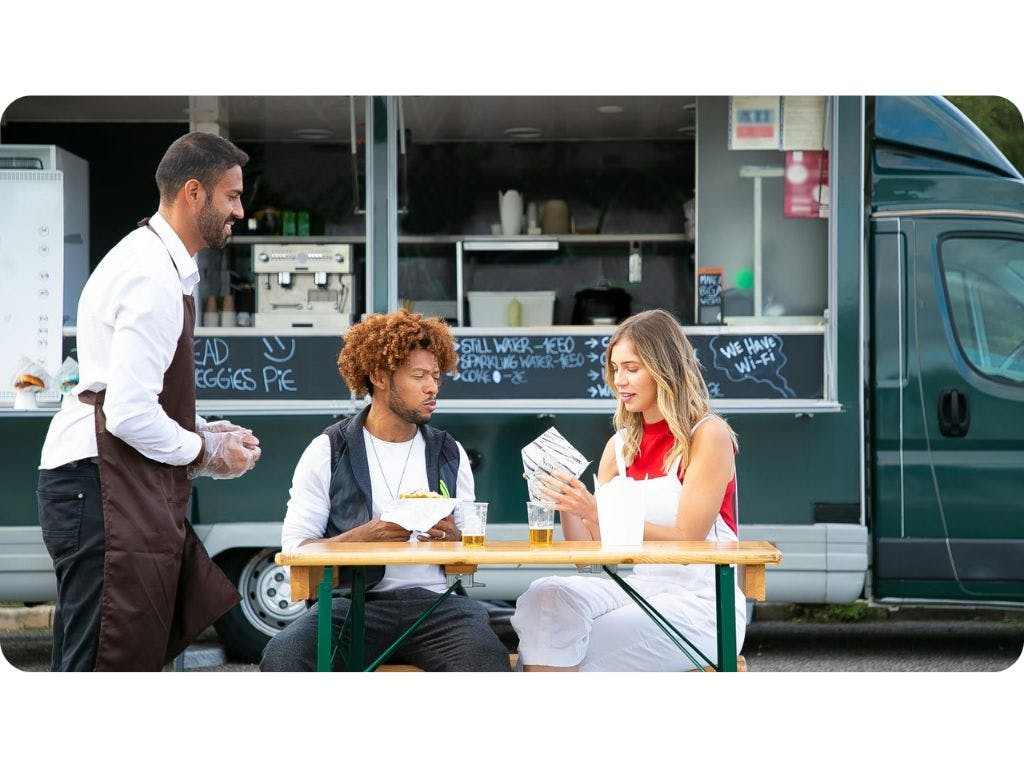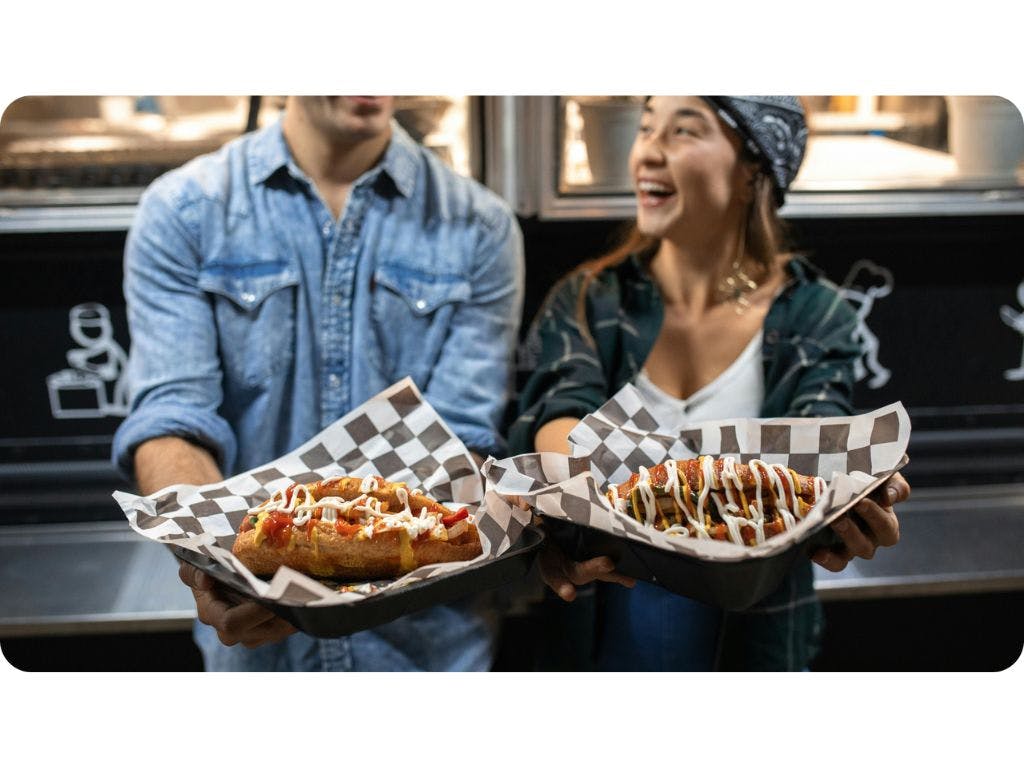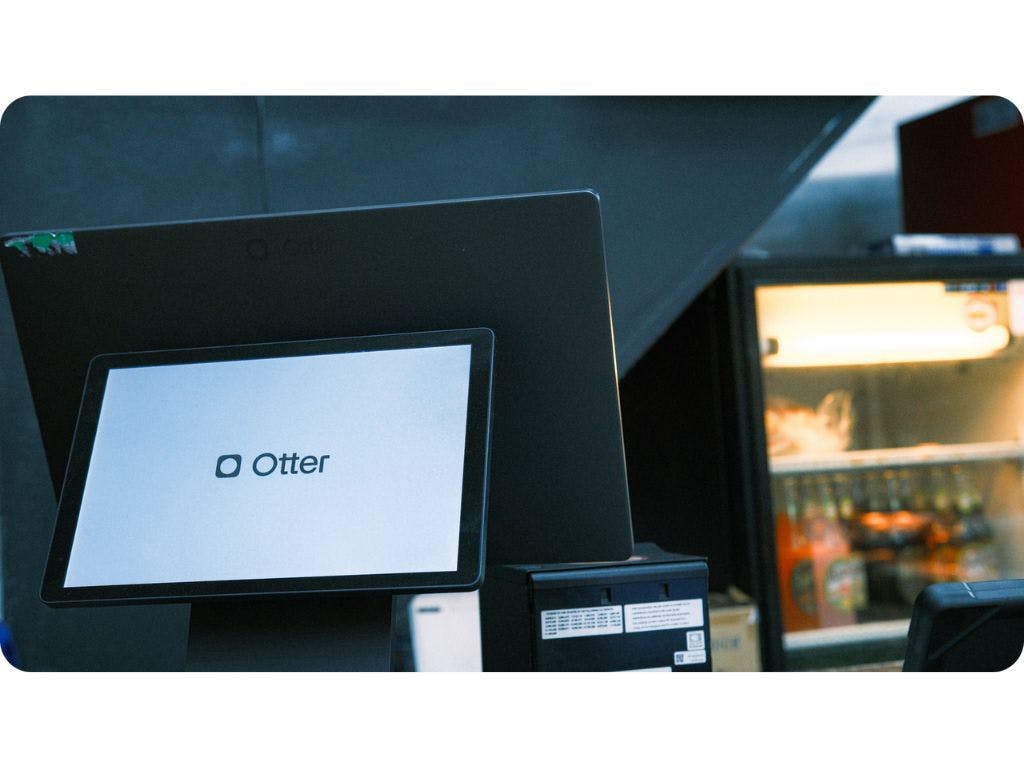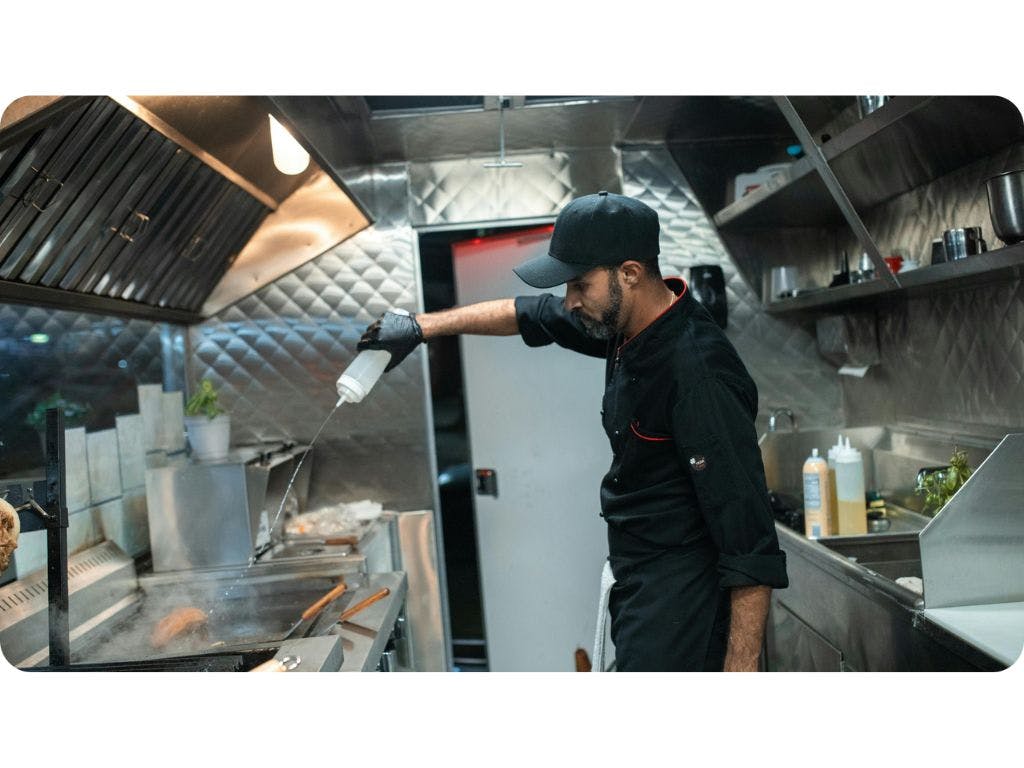
Food trucks – they’re hundreds of years old. In fact, the first food truck can be traced back to the 1800s, when Texan Charles Goodnight repurposed a U.S. Army Wagon into a mobile pantry for traveling cowboys. Still, it took until the early 2000s for the first, modern-day food truck to hit the pavement in Los Angeles, California. Low startup costs immediately attracted brilliant chefs worldwide and a social media craze for the unique vending style made marketing seem relatively easy. And it was.
But things have changed.
Investment remains significantly lower than that of a traditional brick-and-mortar. However, today’s competitive landscape means a well-conceived food truck marketing plan is essential for success. Not sure where to start? We’re here to help. In this post, you’ll learn why and how to build an effective strategy to attract your target audience and increase sales.
Food truck market: an overview

Once a niche dining establishment, food trucks have become mainstream players in the restaurant world. Today, the food truck market is undergoing a dynamic phase of growth, driven by evolving consumer preferences, urbanization, and the quest for convenient dining options. According to IBISWorld, the USA's food truck industry has grown by 10.9%, with more than 58,000 food truck businesses currently in operation. Its market value is projected to grow at a compound annual rate of 6.7% through 2031. The appeal of food trucks is particularly strong among millennials and Gen Z, with over 60% of millennials having eaten from a food truck in the past year. Why? These generations favor a unique and authentic menu over a traditional dining experience. Not to mention, they love high-quality, delicious food.
If it sounds like a recipe for success, that’s because it can be. Studies by Food Truck Profit show that food trucks stand to make an average $346,000 in revenue, significantly higher than a brick-and-mortar. Success doesn’t come without its challenges, though, and a saturated market can present obstacles when starting your business. “When I first started, I didn’t realize how many food trucks were already in the area. It was tough to stand out at first, but by focusing on unique recipes and engaging with customers through a [strong social media presence], I slowly built a loyal following,” says one food truck owner. Regularly diversifying your menu and creating an innovative food truck advertising plan can help you achieve your goals.
10 innovative marketing ideas for your food truck business

Ready to rock? Consider these 10 unique and innovative food truck marketing tools and ideas, many of which don’t require much capital to get started.
1. Utilize social media for real-time updates and promotions
Create dedicated social media profiles on platforms like Instagram, Facebook Threads, and TikTok. Post daily updates about your location and menu specials. Use livestreams to engage with followers, personalizing your content with behind-the-scenes clips, recipe ideas, and interviews with chefs and happy customers. Remember, your content doesn’t need to be perfect - people love authentic, quick updates which makes your life easier too.
How will this food truck marketing idea impact your business? This approach builds a community around your brand, increases visibility, and drives foot traffic to your truck.
2. Partner with local events and festivals
Keep a close eye on upcoming local events, farmers' markets, or festivals that align with your brand identity. Selling tacos in San Francisco? Don’t miss the famous Mexican Independence Day celebration at Civic Center Plaza. Look for related happenings in your area and apply as a vendor or event host to gain exposure.
How will this food truck marketing idea impact your business? Participating in events increases brand awareness, understand your customer demographics, and can significantly increase sales.
Book a demo with Otter to learn about modern food truck tech today.
3. Offer loyalty programs to encourage repeat customers
Airlines and coffee chains use it all the time, because they know the psychology behind loyalty programs keeps their customer base, well, loyal. The desire to achieve status or accumulate rewards taps into internal motivators like competition and achievement, encouraging loyal customers to return again and again. Clients are more likely to choose your food truck for lunch if they know they’re working toward a reward, like the 10th meal free, or a complimentary beverage.
How will this food truck marketing idea impact your business? Loyalty programs foster repeat business by incentivizing customers to return, ultimately increasing retention and sales over time.
4. Create visually appealing food displays
People like to look at beautiful things, and this includes your food truck! Invest in attractive signage and display techniques that showcase your food creatively and appeal to your target demographic. Use vibrant colors, fresh ingredients, and Instagram-worthy culinary presentations to draw attention.
How will this food truck marketing idea impact your business? Eye-catching displays can entice passersby to stop and visually-pleasing plating can encourage them to purchase food, enhancing the overall customer, and vendor, experience. Bonus: customers love to share their experiences online as well, give them something worth sharing.
5. Implement geo-targeted ads
Platforms like Facebook and Google give you the ability to create food truck ads that are targeted according to your potential customer’s location. This means when a hungry patron is nearby, a location-based ad for your food truck will pop up while they’re searching for somewhere to eat on google, browsing food delivery apps, or scrolling social media.
How will this food truck marketing idea impact your business? This strategy increases visibility among potential customers who are nearby, driving immediate foot traffic to your truck.
6. Engage with local influencers for promotions
People love word-of-mouth advertising, which is why influencer marketing has grown in such a robust way. Capitalize on the trend by identifying local food bloggers or social media influencers who align with your brand and will increase your online presence. Many are happy to promote your product on their platform in exchange for free meals.
How will this food truck marketing idea impact your business? Collaborating with influencers can expand your reach significantly, attracting their followers to try your food truck. It might even lead to a personalized hashtag, which might take your small business to the next level.
7. Host special themed days or events
Organize themed days like Taco Tuesday or Meatless Monday (for our vegetarian trucks), showcasing your commitment to a diverse menu. Alternatively, you can host special events to draw customers, like a trivia night or a live music performance. Events can be easily promoted through social media marketing and through local food truck ads.
How will this food truck marketing idea impact your business? Themed events create excitement and anticipation around your food truck, encouraging customers to visit more frequently.
8. Create limited-time menu items or host chef collabs
Incorporate seasonal ingredients or current trends into your offerings to catch the attention of local foodies. If it’s pumpkin spice season, for example, find a way to weave the flavor into your most popular dish. Invite a star chef to collaborate on a limited-time pop-up menu so you can cross-promote to your respective customers. Whatever you choose to do, promote it heavily on social media and at your truck.
How will this food truck marketing idea impact your business? Limited-time offerings, like ingredients or pop-up partnerships, create urgency for customers to visit before the item is gone, driving sales and keeping the menu fresh.
9. Leverage customer feedback for improvement
Perhaps the most important, most overlooked trick of the trade – ask your customers for feedback! Find out what they like and don’t like to create more appealing dishes and improve their customer experience. Actively solicit input through surveys and social media polls. The answers will help clarify your ongoing food truck marketing strategy.
How will this food truck marketing idea impact your business? Engaging customers in this way fosters loyalty as they see their opinions valued while also helping you refine your business strategies. Pro tip: encourage customers to leave you google reviews and give you five starts on delivery apps, naturally helping showcase a positive experience with your brand.
10. Incorporate digital tools to attract customers and streamline routines
In a day and age where everyone wants everything yesterday, digital tools for food trucks are essential. You won’t regret incorporating a reliable POS system or harmonizing online ordering through an order manager like Otter’s Auto-Accept. Tools like these take care of the logistics and leave you time to attend to your very hungry customers.
How will this food truck marketing idea impact your business? Digital tools for food trucks allow for faster transactions, reduced wait times, and an overall improvement in customer satisfaction. This means more customers, more profit, and less stress.
Tracking your marketing effectiveness

Ineffective tracking of your food truck advertising and marketing plans can lead to several setbacks, including:
- Lack of financial awareness, overspending, and profit loss
- Missed opportunities to optimize ad campaigns and reach new clients
- Misallocation of funds and unhealthy investments
Not every campaign is going to be a success. What’s crucial is that you catch what’s not working earlyon so you can try another avenue, and this can only happen with careful tracking. Knowing what works and what doesn’t will help you choose the right location for your food truck, create an attractive menu, drive customer awareness, and, of course, increase profit margins.
How do you monitor the success of your food truck promotions? Here are a few ideas.
Sales data analysis: Tracking sales before, during, and after each marketing campaign. This provides direct insight into the effectiveness of your efforts. For example, if a promotion leads to a noticeable increase in sales, it indicates that the campaign resonates well with customers.
Direct customer feedback: Implementing feedback mechanisms such as surveys or comment cards helps you gauge customer satisfaction and gather qualitative data on their experiences. With this information, you can easily identify what works and what needs improvement.
Social media analytics: Platforms like Facebook, Instagram, and TikTok offer straightforward analytics tools that measure engagement rates, reach, and follower growth. Monitoring which types of content perform best can inform future social media strategies.
Email campaign metrics: Newsletters are still an excellent way to reach your customers. Analyze your open rates, click-through rates (CTR), and conversion rates for valuable insight into what is resonating, and what isn’t. Coupon redemptions linked to specific campaigns are a great way to monitor efficiency.
Customer acquisition cost (CAC): Calculating how much it costs to acquire a new customer through various marketing channels helps identify the most cost-effective strategies. This metric is crucial for optimizing marketing expenditure.
Loyalty program tracking: If a loyalty program is in place, closely monitor participation rates! Know your repeat customer metrics so you can determine which retention efforts have been most successful and the overall satisfaction of your clientele.
Event participation metrics: Signing up to participate in a local festival or concert? Want to set up a pop-up with local breweries? When doing so, it’s essential to track the foot traffic and calculate total sales generated while onsite. This will help determine which future events are worth the investment.
Are you a food truck owner looking to streamline your marketing strategy? Are you itching to gain comprehensive insight into your performance? Book a demo with TryOtter. Our robust tracking solutions can help you measure your marketing effectiveness accurately, enabling you to make data-driven decisions that enhance your business strategy. Otter Marketing even offers AI tools that optimize your spend and ads on delivery apps, saving you valuable time. Don’t leave your success to chance—take control of your marketing today!
FAQs

What is the main mode of marketing for food trucks?
There are several main modes of marketing for food trucks. The primary mode revolves around digital marketing, particularly through social media platforms. Food truck social media is optimized through direct engagement with customers using live streams and stories, using it to announce their locations and promote special offers.
Otter customer IDK Philly, known for their smashburgers, is a pro at using social media to promote their restaurant and expand their customer base.
What are the four Ps of marketing a food truck?
The four Ps of food truck marketing are:
- Product: Unique and gourmet food offerings that distinguish them from traditional fast food vendors.
- Price: Pricing strategies can vary widely depending on the target market and location. Food trucks often adopt competitive menu pricing to attract customers while ensuring profitability.
- Place: Location is crucial for food trucks. They must strategically choose high-traffic areas, events, or festivals where potential customers gather. This can include business districts during lunch hours or popular parks during weekends.
- Promotion: This includes all marketing efforts put into place to raise awareness and attract customers, i.e. social media advertising, delivery app ads, collaborations with local businesses, and participation in community events to enhance visibility.
Who is the target market for food trucks?
The target market for food trucks primarily consists of middle-class millennials and Gen Z individuals between 25 – 44 years of age who value convenience, unique culinary experiences, and social engagement.
What is a marketing budget for a food truck?
Food truck marketing budgets can vary significantly based on the business model, but the general range falls between 5% to 10% of its projected revenue. This budget should cover various marketing activities, including:
- Social media advertising
- Local event participation
- Promotional materials
- Website development
What are the most common obstacles to a successful food truck business?
For entrepreneurs to ensure their new food truck business succeeds, it’s critical to:
- Select a well-trafficked location
- Develop a consistent branding and food truck marketing plan
- Get clear about local regulatory expectations
- Streamline a profitable menu and define product offerings
- Create a financially-sound food truck business plan
- Understand your competitors
How can Otter help optimize a food truck marketing strategy?
By consolidating online ordering systems into a single interface, Otter helps food truck owners streamline order management and make better business decisions. You’ll have a clear picture of customer demographics and preferences, as well as promotional opportunities that can increase sales. By leveraging these analytics, food trucks can enhance their marketing campaigns, drive foot traffic, and ultimately boost profitability. Otter Marketing is the perfect solution for food trucks who need marketing help but aren’t sure where to get started.
How does Otter integrate with existing online ordering systems?
Otter merges all incoming orders – across takeout, in-store, and online – into a single platform, allowing food truck operators to manage both online and offline orders seamlessly. Otter connects with over 100 third-party restaurant services/apps, so users will receive orders directly on the all-in-one Otter platform.
Restaurants and food trucks love Otter POS, which combines everything they need to run their business into one system. Allowing for easy marketing, seamless order and menu management, and strong communication and workflow between front-and back-of-house.
With this information under your belt, you’ll be on the road to a successful food truck business.







